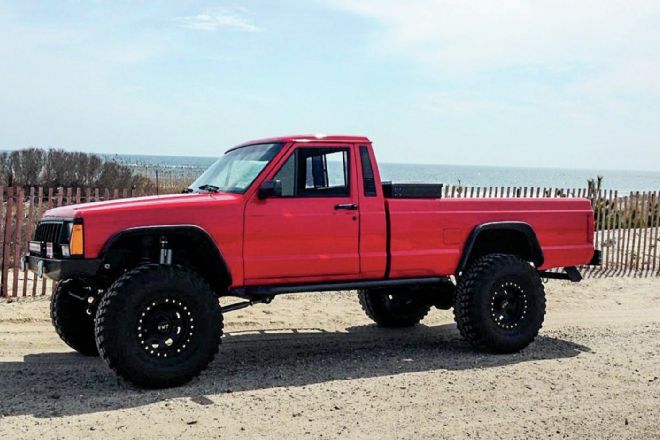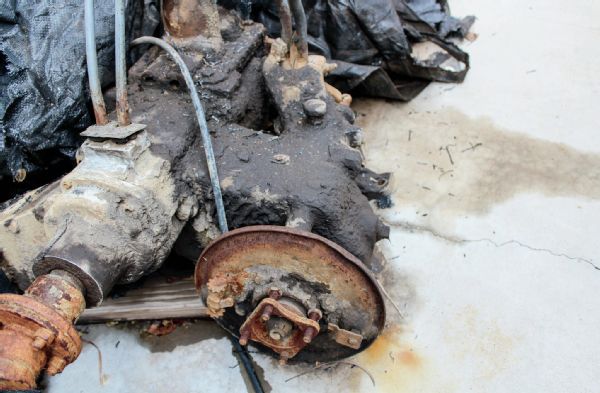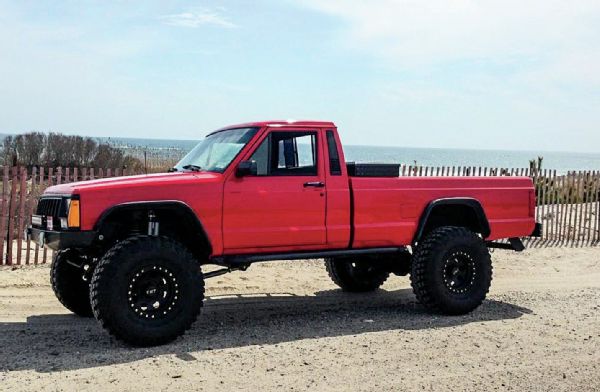
Binder Swap
Q I’m building a ’61 Scout into a reliable trail truck/rockcrawler. So far I have swapped out the scrawny stock axles for 3⁄4-ton Chevy axles (10-bolt front and a semifloating 14-bolt rear), installed Blazer springs in front, and did a spring-over in the rear. Next is a Chevy TBI 4.3L with a TH350 transmission. This leads to my confusion. I want to keep the stock Spicer 18 transfer case for its small size and durability, but, as you know, the rear output is offset to the passenger side. The pumpkin on the swapped-in rearend is centered. Will this create driveshaft issues? Do I need to look for another transfer case? Also, if I use the Spicer 18, should the rear pinion point straight at the T-case (like my lifted Jeep) or match the angle of the T-case? I truly need your expert advice since every internet forum I read has a different answer.
Joe Hardtner
Via nuts@4wheeloffroad.com

A Your Scout sounds like quite the project, and overall you are on the right track. While the axles you’ve chosen wouldn’t be my first choice, I assume that you scored them cheap. Keep in mind that the 10-bolt Chevy front is the same as a 1⁄2-ton, just with eight-lug outers. As such, it would be a good idea to upgrade to a quality set of chromoly axleshafts if 35-inch tires and lockers are among your build plans. In theory, the semifloating 14-bolt rear is stronger than the (likely) Dana 44 it replaced, but it has a ring gear that is an inch smaller than the full-floater 14-bolt most people use for axle swaps (91⁄2 inches versus 101⁄2), and it has rear axleshafts retained by C-clips that cause the whole axle, tire, and wheel assembly to part ways with the vehicle in the event of an axleshaft failure. You should be OK with a V-6 engine, but you definitely want to carry spare axleshafts if you plan on doing anything above moderate four-wheeling with 35s and lockers.
You have reason to be concerned about the rear driveline angle with the Dana 18 and the semifloating 14-bolt. In short, it’s probably not going to work. Your current setup would require the rear driveshaft to run at a compound angle, meaning that it would have to run at an offset angle side-to-side in addition to up-and-down. While I’ve had surprisingly good luck with running compound angles where side-to-side offset was an inch or two, the side-to-side difference is going to be dramatic with your current setup. Combine the offset with a lift and you are guaranteed to fight major driveline problems.
You are correct that the Dana 18 from the Scout is a stout little unit that should be more than up to the task of your build, so there are three ways you can go. The first is to keep the offset transfer case and swap in an axle with an offset rear differential to match the transfer case and width of your front axle, such as one from a fullsize Jeep pickup. They can be hard to find, but they do exist, usually as Dana 44s. Fullsize Jeep donors are most likely going to be a little narrow compared to the front axle, but it should be workable. The second is to have a custom axle built, but this can be expensive. The third and most logical thing to do is give up on the Dana 18 and go to a transfer case with a centered rear output. You have to buy an aftermarket adapter to mate the Dana 18 to a TH350 anyway, so it means sourcing a different adapter and a different transfer case. The Dana 20 and Dana 300 are both excellent choices that have centered rear outputs and are gear-driven, and both of them are just as strong as the 18 with a lot of aftermarket support. Though prices have crept up on both transfer cases lately, you can still find some good deals by scouring Craigslist and other sites. You can put just about any transfer case you want behind a TH350 thanks to companies like Advance Adapters (advanceadapters.com) and Novak Conversions (novak-adapt.com), and both companies offer a number of shifter choices in addition to adapters. By going to a transfer case with a centered rear output, your axle and transfer case choices are almost unlimited.
As for whether the rear pinion should be pointed at the transfer case or parallel to it, that depends on what type of driveshaft you end up running. If you run a driveshaft with conventional U-joints at both ends, then the rule is that the pinion should be at an angle equal to but opposite the angle of the transfer case yoke. Considering the short wheelbase of your Scout and that you will probably be lifting it, I would recommend running a rear driveshaft with a CV joint at the transfer case. With a CV joint driveshaft, you will want to set the rear axle pinion one or two degrees down from parallel to the driveshaft running angle at normal ride height.
Better Brakes
Q I recently purchased a ’12 JK Unlimited. Love it so far. It came loaded with aftermarket upgrades, including AEV front and rear bumpers, an AEV 31⁄2-inch suspension, AEV Wheels, 35-inch tires, and more. The point is that the Jeep now has much more weight than stock and I’m concerned about the brakes. The Jeep has 55,000 miles on it. While I haven’t really checked yet, I feel it probably will need new brake pads soon at a minimum. A look through the wheels shows discs in the front and drums in the back, and both look pretty stock from a size perspective. With all the added weight from the upgrades and the bigger tires, should I swap out the brakes for something bigger? Should I also look at changing out the drums in the back to discs? This Jeep will do more driving on the highway and for shopping than it will on the trails.
Scott D.
Via nuts@4wheeloffroad.com
A Brakes are the most commonly overlooked upgrade item on a 4x4, and you have good reason to be concerned. Not only have you added significant weight to your Jeep thanks to the front and rear bumpers as well as the other accessories, but the 35-inch tires are both heavier and place more leverage on the brakes due to their larger diameter than stock. The factory JK brakes are pretty average when the vehicle is stock, and they become marginal once you add a bunch of weight and larger tires.
You might want to look a little more closely at the rear brakes, because your JK should have disc brakes at all four corners. Fortunately, you have a variety of different brake upgrade options due to the popularity of the JK. These upgrades vary widely in terms of price, so I’ll start low and go high. EBC Brakes (ebcbrakes.com) offers an upgraded set of brake pads for the factory calipers that can help stopping power, and these can be used with the factory rotors or with a set of the company’s Sport rotors, which are slotted to help with heat and pad outgassing. Other companies offer upgraded pad and rotor options, but EBC is one I’ve used in the past. TeraFlex (teraflex.biz) offers a front rotor kit that enables you to upgrade from the stock 11.9-inch-diameter rotors to 13.3-inch-diameter rotors. The kit includes caliper stands to position the stock calipers so they will work with the larger rotors. The bigger rotor gives the brakes more leverage and is perfect to counteract the increased weight and diameter of larger tires. The nice thing about these options is that they are easy bolt-on upgrades that don’t require bleeding the brakes when you are done.
If you want to take your brake upgrades to another level, TeraFlex offers a front big-brake kit that combines the company’s larger rotors with upgraded dual-piston calipers and performance brake pads. Though the installation is a little more involved, the dual-piston calipers offer much more braking force than the stock single-piston ones. It should be noted that TeraFlex highly recommends upgrading to one of its larger bore master cylinders at the same time.
Last but certainly not least, Baer Brakes (baer.com) and Wilwood (wilwood.com) offer complete brake systems that include larger performance rotors, caliper stands, and multipiston calipers that bolt on the front axle. Both companies apply their vast racing knowledge to their brake systems and are the ultimate solution if nothing but the best brakes will do. Interestingly, Baer is the only company I found that also offers a system for the rear, and it includes rotors, calipers, and caliper stands. When considering these high-performance options, pay close attention to their wheel requirements, as most of them are very specific about wheel diameter and offset to clear the larger brake assembly.
Getting Shifty
Q I have an NP241OR out of an ’06 TJ Rubicon that I swapped into my ’89 Jeep MJ with a Novak cable shifter and a new two-piece rear shaft. I had to pull the case from the MJ because I could not get the case to come out of four-wheel drive. Even with the cable shifter disconnected and the shift lever manually moved to 2-Hi, the transfer case was still in 4-Hi. Neutral worked and 4-Lo worked, but it would not come out of 4-Hi. It eventually did come out once I pulled the case from the truck. I thought it was a fluke and put the case back in only to have to same issue. I’m not really sure what the problem could be because I’ve never heard of anyone having the same issue with this case. Could it be something internal or maybe a driveshaft length problem that is causing the case to bind? Thanks for the help!
Ryan
Via nuts@4wheeloffroad.com

A If it shifts fine on the floor but not in the Jeep, my first thought is that it is an adjustment problem with the cable shifter, but it sounds like you’ve already checked that. It still might be worth checking again. Disconnect both driveshafts and the shifter, then manually shift the transfer case through all the ranges using the little lever that’s right on the case. If it shifts into all the ranges normally, then it’s a simple adjustment problem. I’ve had some experience with the Novak cable shifter in the past and know it is a very high-quality piece, but getting it adjusted properly can take a little time. Follow the directions that came with the shifter and try again. To double-check yourself, disconnect the cable shifter and manually shift the transfer case into 2-Hi. Then put the Novak shifter in 2-Hi. When the cable is adjusted properly, the end of the cable should line up with the hole in the lever on the transfer case.
If it still won’t go into 2-Hi with the transfer case installed in the Jeep but with the driveshafts and the cable shifter disconnected, make sure the little lever on the T-case isn’t hitting something that’s preventing it from going into 2-Hi. If that checks out, make sure the output shaft of the transmission isn’t bottoming against the transfer case input and binding up the case. You didn’t mention what transmission you were running, but output shaft stick-out lengths vary depending on the transmission type and model year. If all of that checks out but the transfer case won’t go into two-wheel drive with the driveshafts hooked up, then there’s some other problem with either the driveshafts or the axles. It seems unlikely that driveshaft lengths would be the culprit, since it would be pretty obvious when trying to hook them up to the transfer case. Lastly, though it is unusual for an NP241OR, the shift fork could be bent. The only way to check that is to crack open the case and inspect it.
Submission Information
Confused? Email your questions about trucks, 4x4s, and off-roading tech using “Nuts, I’m confused” as the subject and include a picture (if it’s applicable). Digital photos must measure no less than 1600 x 1200 pixels (or two megapixels) and be saved as a TIFF, an EPS, or a maximum-quality JPEG file. Also, I’ll be checking the forums on our website (4wheeloffroad.com), and if I see a question that I think more of you might want to have answered, I’ll print that as well. Otherwise drop it old-school style with the envelope addressed to the address below. Letters published in this magazine reflect the opinions of the writers, and we reserve the right to edit letters for clarity, brevity, or other purposes.
Write to: Nuts & Bolts, 4-Wheel & Off-Road, 831 S. Douglas St., El Segundo, CA 90245
Fax to: 818.566.8501
Email to: nuts@4wheeloffroad.com